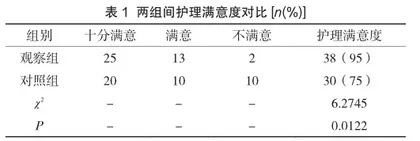基于人性化护理模式下慢阻肺无创呼吸机护理的效果及满意度分析
作者: 彭文婷

【摘 要】目的:探讨人性化护理在慢阻肺无创呼吸机患者护理中的应用效果。方法:抽取了我院2020年2月至2021年2月的80例慢阻肺患者进行研究,经计算机表法分组分为观察组(总计40例)、对照组(总计40例)。观察组施行人性化护理模式,对照组实施常规护理模式,比较两组的护理效果。结果:观察组在护理满意度方面和对照组比较,组间的数据差异存在(P<0.05、2χ=6.2745)。观察组在并发症发生率方面和对照组比较,组间的数据差异存在(P<0.05、2χ=3.9139)。结论:慢阻肺无创呼吸机护理中人性化护理模式的实施,可提高患者护理满意度并降低并发症发生率,故此值得在临床上应用和推广。
【关键词】人性化护理;慢阻肺;无创呼吸机;护理效果;满意度
Analysis of the effect and satisfaction degree of non-invasive respiratory machine care for chronic obstructive pulmonary disease based on humanized nursing mode
PENG Wenting
The First Hospital of Changsha , Changsha, Hunan 410005, China
【Abstract】Objective:To explore the effect of humanized nursing in the nursing of patients with COPD non-invasive ventilator. Methods:A total of 80 patients with COPD in our hospital from February 2020 to February 2021 were selected for research, and they were divided into observation group (40 cases in total) and control group (40 cases in total) by computer table method. The observation group implemented a humanized nursing model, and the control group implemented a conventional nursing model to compare the nursing effects of the two groups. Results:Comparing the observation group with the control group in terms of nursing satisfaction, there was a difference in data between the groups (P<0.05, 2χ=6.2745). Comparing the observation group with the control group in terms of complication rate, there is a difference in data between the groups (P<0.05, 2χ=3.9139). Conclusion:The implementation of humanized nursing mode in COPD non-invasive ventilator care can improve patient care satisfaction and reduce the incidence of complications, so it is worthy of clinical application and promotion.
【Key?Words】humanized nursing; COPD; non-invasive ventilator; nursing effect; satisfaction
慢性阻塞性肺疾病COPD,简称为慢阻肺,属于发生率较高以持续气流受阻为主要特征的疾病[1]。发病机制:外因有吸烟、粉尘、化学物质等吸入,以及空气污染、呼吸道感染等,内因包括遗传、气道反应性增高、新生儿、婴儿期/儿童期等相关因素所致肺发育或是生长不良的个体等[2-3]。主要表现:慢性咳嗽、咳痰、气短/呼吸困难、喘息等。临床上多会选择无创呼吸机辅助治疗,这个过程中为巩固临床疗效建议配合护理干预,因此本次研究选择我院2020年2月至2021年2月的80例慢阻肺患者作为探究对象,重点评判人性化护理模式、常规护理模式的临床价值。
1 资料与方法
1.1 基本资料
选择我院2020年2月至2021年2月80例慢阻肺患者,按照计算机表法分组分为了观察组和对照组,每组均各40例。观察组,男23例,女17例,年龄28岁~72岁,平均年龄(50.6±2.3)岁,病程2个月~4个月,平均病程(3.2±0.5)个月。对照组,男24例、女16例,年龄30岁~72岁,平均年龄(51.4±2.5)岁;病程选取2个月~5个月,平均病程(3.5±0.6)个月。两组慢阻肺患者的基线资料比较,无统计结果差异性(P>0.05)。
纳入标准:①通过慢阻肺诊断标准;②自愿参与到本次研究;③患者和其家属签订了知情同意书。
排除标准:①精神障碍;②传染性疾病;③ 临床资料不全。
1.2 方法
1.2.1 对照组实施常规护理模式,进行相关检查、告知患者相关需要注意的事宜。